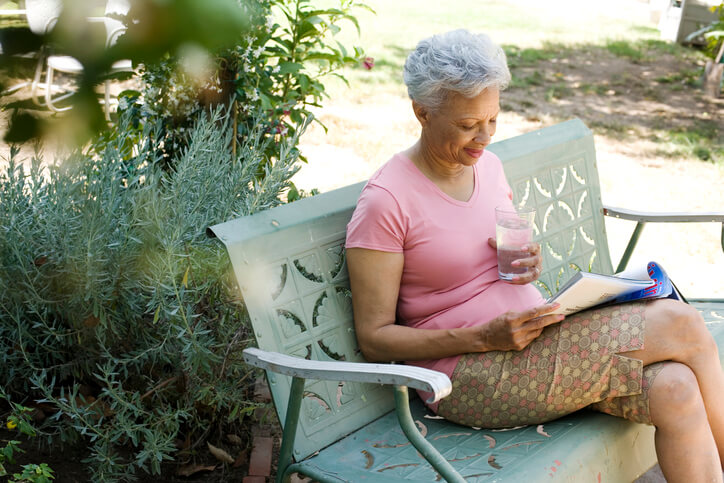For all the known science on sun safety and skin protection, it’s unfortunate that so many myths persist. Maybe it’s time to bust them.
After all, your health is at stake. Not only can sun damage lead to sun spots, wrinkles and other changes in your appearance, but more importantly, exposure to the sun’s ultraviolet rays can raise your risk for skin cancer and other problems with your physical health.
Clinging tightly to old wives’ tales can exacerbate those problems. One egregious example that you should definitely not do: Using mineral oil instead of sunscreen. Whereas people once thought it gave skin a healthy glow, it’s now known to raise the risk of potential damage. Luckily, that one’s not nearly as popular as it once was—but there’s a lot of misinformation still out there.
So if you think you can decipher between what’s true or what’s not, put your knowledge to the test with the following myth-or-fact lineup.
The Basics of Sun Exposure
Truth or Myth? You can’t burn if it’s cloudy outside.
Myth! Even on cloudy days, 80% of UV rays can reach the skin.
Truth or Myth? Snow can cause sunburns.
Truth! Ultraviolet rays can reflect on bright white snow and penetrate your skin.
Truth or Myth? You don’t have to wear sunscreen under your clothes.
Myth! UV rays can penetrate through certain fabrics like sheer cover-ups, but there are certain clothes actually rated for UV protection.
So, how did you do?
If you didn’t get them all right, that’s okay. Lots of people can underestimate the sun’s ultraviolet (UV) rays. With the ability to penetrate through clothes or cloudy skies or even reflect off snow, UV radiation is powerful stuff.
When you’re exposed to sunlight, UV rays can reach the inner layers of your skin, where they damage or even kill skin cells. And that can be dangerous. Long-term UV exposure is the top cause of skin cancer.
That’s why practicing sun safety is a key step you can take to support your preventive health—right along with eating healthy and getting more exercise.
Protecting Against UV Rays
Truth or Myth? Only broad-spectrum sunscreen protects against both types of UV rays that can cause skin cancer.
Truth! Broad-spectrum protects against both UVA and UVB rays. Always check the label.
Truth or Myth? The sun’s rays can harm your skin in just 15 minutes.
Truth! Even a quick errand outside can expose you to harmful rays.
Did you get them all?
As we said, those rays are powerful stuff—but they’re double the trouble because there are actually two kinds to worry about: UVA rays and UVB rays. The sun emits both, but each acts a little differently.
UVB rays can affect the top layers of the skin, which can lead to sunburns. UVA rays can reach deeper into the skin’s layers, which can lead to early aging. However, both types of rays can raise your risk of skin cancer.
To protect yourself from UVA and UVB, experts recommend a broad-spectrum sunscreen with an SPF 30 or greater. Pick one that’s water-resistant, too.
Other tips include finding shade and wearing protective clothing, like long-sleeves or pants, with densely threaded fabrics that are less likely to allow light to pass through. It’s also a good idea to stay inside from 10 a.m. to 2 p.m.
Skin Cancer and Sun Damaged Skin
Truth or Myth? Sun damage can make your skin age faster.
Truth! UVA exposure can lead to sun spots, fine lines, wrinkles and other appearance changes.
Truth or Myth? Skin cancer always starts as a mole.
Myth! While many forms of skin cancer may look like a mole, some may appear yellow, pale, reddish or translucent instead.
Truth or Myth? Just one bad burn as a child increases your risk of getting melanoma later in life.
Truth! In fact, it can more than double your risk.
Did you find the myth?
Sun damage and sunburns can have various impacts on the skin—from sun spots and sunburns to cancer risk. For the first two, experts often recommend self-care, such as using sunscreen to prevent further burns or using a moisturizer with aloe vera.
Skin cancer risk can be a little scarier. Most skin cancers fall into three different groups, with the first two usually being among the most treatable:
- Basal cell carcinoma
- Squamous cell carcinoma
- Melanoma
Basal cell carcinomas can cause a scar-like area or even a red bump that itches. Other signs can include pink growths that sink down in the middle or open sores. Squamous cell carcinomas might appear as a patch of skin that’s rough to the touch, an open sore or a bump that looks like a wart or growth.
Melanoma can be more dangerous. This type of skin cancer can often cause signs known as the “ABCDE rule”:
- Asymmetrical
- Irregular borders
- Inconsistent color
- Diameter larger than .25 inches
- Evolving size
Signs of skin cancers can vary quite a bit, however, so it’s best not to self-diagnose based on something you read on the internet and instead see a dermatologist regularly. Get suspicious marks or growths checked out by a dermatologist who can do a physical exam along with any recommended testing.
Getting the Benefits of Sun While Staying Protected
Truth or Myth? You miss out on all the benefits of Vitamin D if you wear sunscreen.
Myth! A week-long study done during sunny weather in Tenerife showed that people who used sunscreen still had “excellent Vitamin D synthesis.”
Truth or Myth? The sun can actually boost your mood.
Truth! Seasonal affective disorder can be caused by a deficiency in Vitamin D. It’s most prevalent in the winter months and rainy climates.
Did you get those right?
Hopefully so! While sunlight may offer some benefits of helping the body make Vitamin D, which can help support bone health or even pep you up, too much of it can affect your skin health. Even the American Academy of Dermatology suggests that the best way to get Vitamin D is through your diet, rather than the sun.
So despite those benefits, it’s still important to protect yourself from UV rays by wearing sunscreen, seeking shade and covering your skin.
Wearing Sunscreen Myths and Facts
Truth or Myth? Sunscreen lasts forever.
Myth! Sunscreens can expire. However, the FDA requires a sunscreen’s effectiveness to last for at least three years.
Truth or Myth? You should reapply sunscreen every two hours or sooner if you get wet.
Truth! Sunscreen can wear off with time and also wash off when you perspire or get wet. Always reapply so that you can keep your skin protected.
How did you do?
Sunscreen, like UV rays, can be powerful stuff—and also like UV rays, there are two types of sunscreen to know about: mineral sunscreens (like zinc oxide) and chemical sunscreens (like oxybenzone). Physical sunscreens create a protective barrier on your skin, while chemical sunscreens help your skin absorb and scatter out the rays. Many sunscreen products contain a mix of both physical and chemical ingredients.
However, to get the full benefit of your sunscreen, you have to use it correctly—and that means using enough. You should apply your sunscreen all over your body and make it a good amount. Aim for about two tablespoons of sunscreen for each use. Within an afternoon, a family of four could expect to go through an eight-ounce bottle of sunscreen.
And don’t forget to reapply. You should always reapply sunscreen after you go swimming or sweat, but at least every two hours nonetheless.
Are You Sun-Safety Savvy?
Remember, sunlight may offer health benefits like helping your body make Vitamin D—but UV rays can also be harmful to your body, leading to cancer risk and cosmetic concerns.
However, you can still enjoy outdoor time if you’re savvy about sun safety! Consider sun protection an important part of your daily healthy lifestyle.
Did you learn anything new? How do you protect yourself from the sun’s damaging rays while still enjoying time outside in the summer? Let us know in the comments!







The information was very informative I really enjoyed it reading and learning new things thank you
Thank you need to know.
So appreciated the sun safety reminders. I actually went to a dermatologist because of the info you shared to check on a skin growth which they biopsied. Thank you for the needed prompting. Waiting for the results
Great informative quiz!!
First, since most of us are under Daylight Savings Time not regular time, in Summer, the times to avoid the Sun should be 11 am to 3 pm, not 10 to 2. With DST, the Sun is at its highest around 1 pm, not noon as with real time.
Second, among the best protections is a good Sun hat with a wide brim. This protects the scalp, ears and nose, but also the lips and the eyes which no sunscreen can do.
Thank you. This is very helpful
Looks like knowledge i gained by age. Got them all. Great thoughts to ponder though for those who need to be aware.
Very informative!
great info thanks for sending,
I have found it very difficult to find an actual dermatologist who wants you to live. So many of the doctors listed as dermatologists are really cosmetologists who seem to want to help you be beautiful when you die because they do not check your skin for cancer. I am very careful when I make an appointment for my annual skin checkup. I have had melanoma so I’m very conscious of my skin and have educated myself on what to watch/look for to ask a doctor about. So when I book an appointment, I make sure to ask if the doctor is more interested in making you beautiful or keeping you alive by checking your skin for cancer. I also check their website, and especially the reviews, to make sure what their main goal is. If it’s about cosmetics, I keep looking for a real dermatologist. Be careful what doctor you see!